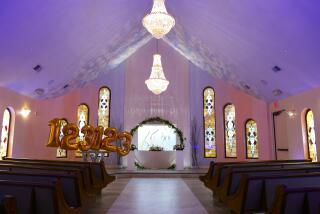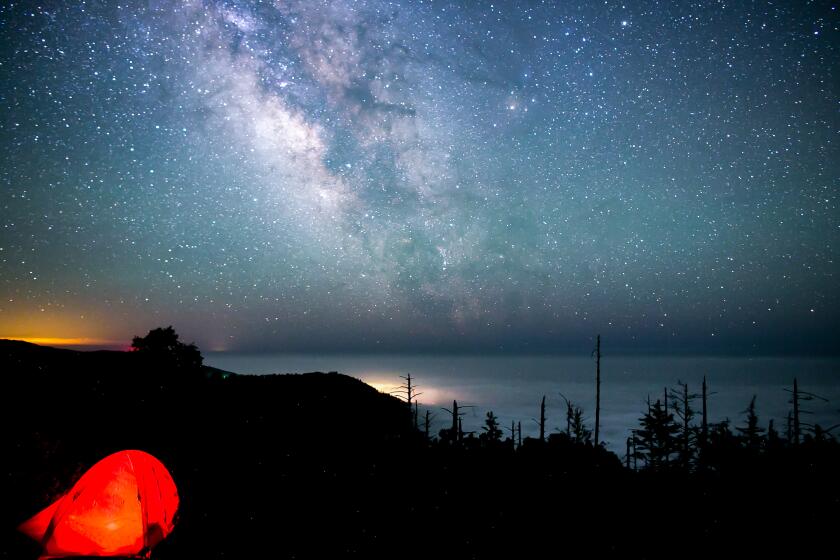Bellagio’s floral show blooms in Las Vegas
The bloom is long off the rose in most parts of the country, but the impending breath of winter is but a poetic possibility in Las Vegas, where anything that can be conceived can happen.
Lilacs in February? No problem. Crocuses in July? Done. If it can grow in a pot and hold a brilliance of color in its petals and shoots, it will find its way to the Bellagio’s botanical conservatory.
When Steve Wynn opened the multibillion-dollar resort in October 1998, the sky was the limit. And he honored that pledge with a firmament of swirling glass flowers crowning the hotel lobby, an original hand-blown masterpiece by Dale Chihuly.
But the floral symphony in glass turned out to be only a prelude to the next display greeting the crowd. A 13,573-square-foot atrium lay just beyond the check-in desk with a 55-foot-high ceiling of French glass to let the sun pour through to fantastic displays.
Today, tens of thousands of plants and flowers are employed and sculpted into new scenes and sets with every season -- five in all, if you count the Chinese New Year.
This fall’s fete brings leaves in full color. They sway from the rafters as gorgeous glass complements the harvest scene below. A Vegas bride in a white puffy gown, sated from the buffet where her wedding party just dined, poses astride a pumpkin as big as a Volkswagen. She walks with her groom down a wooden bridge, beneath arching arbors made of dried pomegranates and crimson holly berries, and through arcing water columns that shoot from one side to the other like rice in a ceremonial send-off.
A covered bridge set pops out of another corner of the layout, and a mossy, misty Irish bog creates a fairy tale forest on the opposite side of the room. A sea of chrysanthemums in brilliant crimsons and bright siennas covers the conservatory floor. And Las Vegas gets a hint of New England’s chill in a sliver of space on the Strip.
All of this is managed by a battalion of round-the-clock horticulturalists who keep the fountains churning and the plants growing -- plants that usually have to be replaced every two weeks -- in design schemes that, according to conservatory manager Jim Hunter, are always a work in progress.
“We often start on a design, and maybe we have actually laid the whole scheme out when we find that we’ve ordered the wrong flowers or the water feature we had in mind does not work,” Hunter says. He supervises about a dozen gardening experts, many with advanced degrees in horticulture.
Most conservatory productions gain the benefit of input from Wet Design, the firm that created Bellagio’s famed fountain show.
But even the best water artists slip up. Hunter recalls a fishpond in a Chinese New Year’s exhibit that flopped badly, so to speak. “We don’t do fish anymore,” he says.
And then there was the time the staff was preparing for the spring show and the room started smelling like the back trough of a dairy farm. The blooms had to be pulled and something subbed in a hurry.
In fact, chaos is rather the rule of these designs, not the exception. After all, the props are living.
For each change-out of design, the botanical team has to plan a good eight months in advance, starting with looking at last year’s seasonal schematics, seeing what might be built from those, trying not to repeat concepts too closely and settling into some dynamic brainstorming sessions. Once the plans are inked, flowers have to be ordered (it usually takes six months to grow the volume required, easily in the tens of thousands for the duration of a set). When it’s show time, crews of more than 100 gardeners, engineers, designers and prop specialists work around the clock in two shifts for a week.
At the end of the week comes the hard part, Hunter says. “You have to see what’s working and what isn’t, and if something is not working, you had better have a Plan B for it.”
Plan Bs, such as ordering a rare bloom from New Zealand when a local shipment comes in dead, are not unusual.
“These things have to be handled in a day,” Hunter says. “You have to get pretty creative sometimes. People apply for these jobs not realizing that, first, you’re going to get dirty and, second, you are going to be under a great deal of pressure. It’s really quite different from gardening.”
To accent the experience, Bellagio sprays the finished space with perfumed scents. The effects of the various scenes change as the day passes, as natural rays streaming through the ceiling glass give way to colored spotlights at night.
“We never really know what we’re going to do or how it is going to work out,” Hunter says. “But in the end, we know it will be worth the effort, whatever it turns out to be.”
***
FLORAL SHOW INFO:
Dates when seasonal displays begin at the Bellagio:
Holiday show: Dec. 1
Chinese New Year: Jan. 12
Spring celebration: March 15
Summer garden party: May 17
Harvest show: Sept. 13
Comments? Email travel-feedback@latimes.com
More to Read
Sign up for The Wild
We’ll help you find the best places to hike, bike and run, as well as the perfect silent spots for meditation and yoga.
You may occasionally receive promotional content from the Los Angeles Times.






